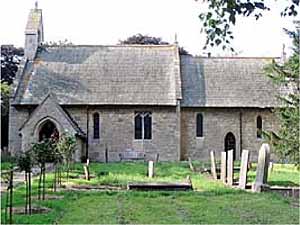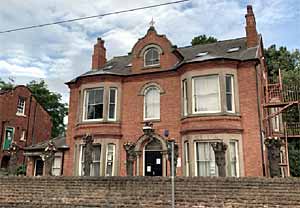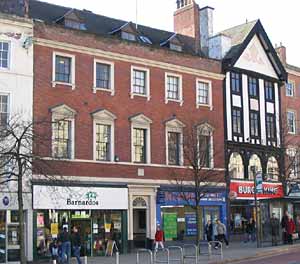News
THOROTON RESPONSE GROUP
Outcomes of recent Response Group representations
 Church of St James, Halloughton.
Church of St James, Halloughton.Very regrettably the wonderful landscape around the conservation village of Halloughton, near Southwell, will be covered by solar panels following the appeal against refusal by Newark and Sherwood District Council being won by the applicants. The entrance to the solar farm is next to the Church of St James, in the churchyard of which Sir Frank and Lady Stenton lie.
We still await the outcome of another application near Southwell - a Sainsburys food store on an elevated site overlooking Southwell, which is also potentially archeologically important. After a number of amendments to the application, mainly about the access to the site from the road into Southwell, we await the outcome.
An application was made for building on land in Rolleston associated with the childhood abode of the 19th century writer, artist and illustrator, Kate Greenaway.
A local group is resisting the proposals and we also made a representation regarding the loss of this significant open area. The land is currently owned by the County Council. Again, the outcome is awaited.
The site where the now listed Majestic Cinema on Woodborough Road stands is again subject to a planning application. This time the cinema building is proposed to be retained and it is therefore hoped this will secure its future. Subject to the building being safeguarded and with sympathetic plans for its future use, no objections were made.
A member let us know of concerns regarding an application for 4-storey buildings on an elevated position as part of new estate on the former Elms School site in Nottingham. Representation was sent to Nottingham City Council - outcome awaited.
 Oban House, Beeston
Oban House, BeestonMost recently, a member alerted us to a proposal to demolish the 19th century Oban House, part of a conservation area in Beeston and near to the parish church. There had been many objections to this plan - the outcome is again awaited.
Exhibition at Newstead Abbey, Ethel Webb’s Japanese Garden
April 2nd to August 31st 2022 - Weekends only 12 - 4
The Japanese Garden at Newstead Abbey, Nottinghamshire, which visitors enjoy today was created under the direction of Ethel Webb (reputedly ‘one of the best amateur gardeners in England’), between 1899 and 1914. This exhibition is inspired by Ethel’s Japanese Garden and celebrates the cross-cultural exchange between Britain and Japan during this period. It features a series of botanical illustrations loaned from the collections of the Royal Botanic Gardens, Kew, alongside historical material and objects from the collections of Nottingham City Museums, which includes Samurai armour, vases, decorative screens, bronzes and even a temple bell! As well as exploring Ethel’s garden the Exhibition looks at some of the Japanese plants that have become a permanent feature of British gardens. The illustrations by leading British botanical artists include works by Lillian Snelling (said to be the most important British botanical artist of the first half of the twentieth century), Stella Ross-Craig, Ann V. Webster and Walter Hood Fitch.
The Exhibition opened on Saturday April 2nd 2022 with a talk at Newstead Abbey at 2 pm by garden historian Philip E. Jones entitled Ethel Webb and the Japanese Garden at Newstead Abbey.
The Bendigo Heritage Project
This is project is promoting ‘The Bendigo Story’ on several fronts. This ranges from a Guided Tour to publications, merchandise, establishing an archive of images and items for exhibitions and other events. They also seek to ensure that the local authorities are aware of and celebrate The Bendigo Story at every opportunity. One area is to maximise awareness of Bendigo using civic plaques and visitor signage. The latest task is to install a blue plaque at the former Forest Tavern on Mansfield Road. Contact: Alan Dawson - Trustee Bendigo Heritage Project. Mob: 07910663233 www.bendigofunds.co.uk/about/
BROMLEY HOUSE LIBRARY RESTORATION
 Bromley House
Bromley HouseA major restoration of Bromley House was completed in 2019. The work took about nine months and cost over £800,000. The architects were Peter Rogan and Associates Limited and Ackroyd Construction Ltd were engaged as the contractors. Various other specialists were involved in the work. The new lighting, essential in a library, was designed by Light Perceptions Ltd of High Wycombe. Historic England were heavily involved with the whole project. They arranged for a dendrochronology survey of some of the roof timbers which were exposed during the restoration. Most of the timbers date from just before the construction of the building in 1752, as might be expected. However, there are a couple of earlier timbers, dating to feelings of 1594 and 1652 respectively. These are thought to have been reclaimed and re-used from the building that stood on the site previously. The main problem was the roof, which leaked in places due to an inadequate and convoluted drainage system, and this was completely re-tiled with new tiles at the front and old tiles re-laid at the back. The restoration also provided an opportunity to make a number of changes to the upper part of the building.
The rather cold and uninviting attic rooms have been converted into very comfortable study rooms. The original metal shelving in the Studio was restored and retained and new shelves were custom made for the other rooms. New light fittings have been installed, giving soft but clear illumination of the book stock. Power points have been installed in the floor under the large study tables, so that laptop computers can be plugged in.
The Thoroton Room
There had been a problem with the ceiling in this room, formerly the home of the Thoroton Society. The ceiling had been sagging for some time and before the restoration work began it was held up by a scaffolding pole. Fortunately, when work began in earnest, it was discovered that only the plaster was sagging and there was no major structural problem. The ceiling is now fine and structurally sound. The Thoroton Room has had a change of use and is now a centre for local history studies.
The Attics
The Attics have been greatly improved. One small room has been converted into a Children's Room, with comfortable seating and a 'Narnia' door that leads to the next room. The door incorporates a large mirror, and has an engraving of Aslan the lion, from the Narnia stories of C.S. Lewis, in the top right-hand corner of the door frame.
The Photographic Studios
The photographic studios have been transformed into comfortable, usable study rooms. The large room’s original skylight once had a revolving dome, but no trace of the mechanism for this is now in existence. Instead, a very fine skylight has been built, giving a wonderfully even light over the work table. In a smaller room there is an exhibition of old cameras, and panels telling the history of the photographers who rented the studio until about 1955. Some of the racks for drying and storing glass photographic plates have been left. One modest room, too small to be of much use as a study room, has been unchanged and shows the original reed and plaster construction.
Conclusion
The enhanced facilities indoors and a considerable amount of work in the garden combine to reflect the 18thand 19th century origins of Bromley House. The Library owes much to the dedicated, sensitive and patient work of the staff, contractors and volunteers, and to the ongoing support of the members, throughout the noisy and dusty work that took place.
John and Janet Wilson
FONA’S FIRST PODCAST - Our Green and Pleasant Town
The Covid pandemic challenged us all to find new ways of engaging and interacting with each other. Chairwoman Judith Mills was determined that the Friends of Nottinghamshire Archives would continue to offer its members an interesting programme of FONA events, even during lockdown. One of Judith’s ideas was to create a radio-play type broadcast. Lockdown also provided inspiration for the podcast’s subject matter by way of the growing appreciation of public green spaces. In 2013 Judith worked on a community history project led by John Beckett, The Social World of Nottingham's Green Spaces, which produced a wealth of research on the development and use of these spaces; research that was then shared with the community of Nottingham in a variety of ways, including a play by Andy Barrett, Breathing Spaces, all of which can be found on the website www.ng-spaces.org.uk Could we do something similar to continue sharing the work of this project? Our Green & Pleasant Town is the result, a four-part series exploring the creation of Nottingham’s first public green spaces following the 1845 Inclosure Act in the form of a dramatic recreation using first hand contemporary accounts. The diaries of Samuel Collinson (Nottinghamshire Archives) and William Parsons (University of Nottingham Manuscripts and Special Collections) were invaluable. As were the memoirs of the shoemaker, John Holmes (Southwell Library) and James Hopkinson (“Memoirs of a Victorian Cabinet Maker”). In episode 1, Towards A New Nottingham, we explore the conditions in the town prior to 1845, and why the creation of public green spaces was urgently needed. Episode 2, Green Lungs, tells the story of the first four public walks, Elm Avenue, Corporation Oaks, Robin Hood Chase and Queen’s Walk through the eyes of those who created them, enjoyed them and policed them. While episode 3, Honour & Ornament, delves into the radical origins and early history of Nottingham’s Arboretum. Finally, episode 4, The Forest Recreation Ground, brings to life the history of the Forest’s development and the racier attractions it offered.By turns shocking and amusing, grim and light-hearted, this series is always informative and entertaining.You can listen for free on FONA’s website, www.fona.org.uk by clicking on the YouTube icon on the home page, where you will also find another of FONA’s answers to the Covid challenge, our series of short videos, FONAbytes.
Alternatively, you can download the podcast for free from Spotify https://anchor.fm/ friends-of-nottinghamshire-archives
Karen Winyard